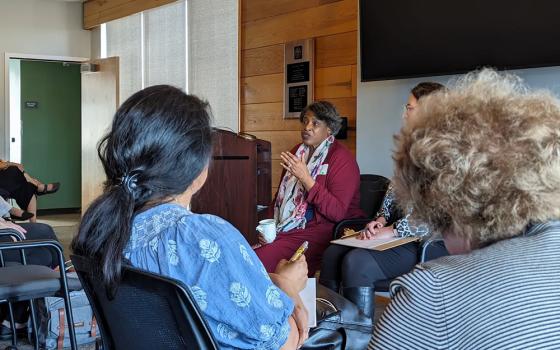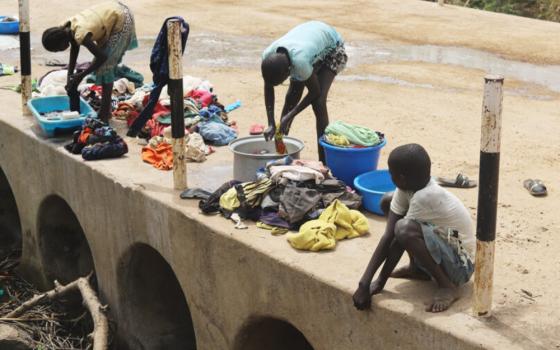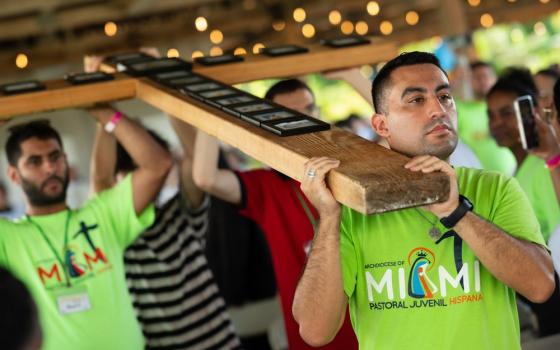
WASHINGTON -- U.S. church institutions are "horribly underfunded" and will face growing cutbacks if Catholics don’t begin to give more and make greater commitments to the church’s mission, said Francis J. Butler, president of Foundations and Donors Interested in Catholic Activities. Butler has headed FADICA, a membership organization of many of the leading Catholic-oriented foundations in the country, for more than 25 years. NCR asked him to spell out some of the main issues for Catholic philanthropists today. The following are excerpts from that interview.
NCR: What are some of the main concerns of Catholic foundations and philanthropies these days?
Butler: Well, I can tell you what FADICA itself has as a focus at the present time. There would be four areas. One cluster of concerns is around Catholic schools. Another would be the area of generosity, giving and stewardship. Connected to that is the fact that so many Catholic institutions these days are horribly underfunded. So we talk a lot about the operations of Catholic institutions, particularly dioceses and parishes. An additional area is engagement of young people in the church and their participation in the life of the church.
If you gathered any group of foundations associated with FADICA, you’re going to find those conversations dominating — schools, generosity and stewardship, and the engagement of young people.
Why don’t we start with schools. What are your concerns there?
The big picture, of course, is getting to be well known by everyone. Since 2000 they say that we’ve lost about 460,000 students nationwide. We’ve lost about a fifth of the capacity [that the schools had in 2000], so it’s quite dramatic.
Are you talking about grade schools and high schools together?
Yes. But this is most acute at the primary, grades K-8, levels, typically parish schools — and especially in the urban areas. It is a tragedy.
And it also is a barometer of the attention we’re paying to the future of the church. The whole task of Catholic education is becoming more challenging. There are a lot of reasons for that, and one is just that the world is becoming more secularized and the value of faith-based education is diminishing.
But they’re worth saving. Historically they’re the producers of our Catholic culture, our donor base, our active parishioners. They’re very, very powerful formative institutions for the Catholic faith. So it’s shortsighted to let these things slip into oblivion.
When you look at the schools themselves to see where the problems are, of course a large part of it is the financial base. The other main challenges have been in finding the right leadership for these schools and addressing quality questions, governance questions and so forth. They all sort of come together: If you don’t have those operative elements in a school, you’re going to run into trouble.
The good thing is that now educators are beginning to talk about this more openly, and the NCEA [National Catholic Educational Association] is in what I would consider a new chapter of frank discussion. Very constructive materials have been put out to help dioceses identify the at-risk schools and to take steps to remedy that.
What are FADICA members doing to assist in this process?
I would say there are very few FADICA members who are not helping in the schools. We have people who are directing their own diocesan schools foundations and doing everything they can. They’re even teaching in the schools. Some of them are struggling with very hands-on work. As an illustration, I serve on the board of a foundation in Dayton, Ohio, that is really crucial to the future of the Catholic schools there and has been working diligently for many years to save those schools and help them prosper.
Some are engaged at the university level. We’re seeing more action by the Catholic universities with schools of education to do their part. I have to say, historically they have not had the Catholic schools in their academic focus the way that they do now. So that’s encouraging.
Connected to that is the ACE [Alliance for Catholic Education] program begun at Notre Dame, which I understand has spread to other universities. What was FADICA’s role in that?
Our individual foundations have certainly been backers of the ACE program. It’s one of the true successes in education, and it’s just an amazing effort. The number of young people that they have brought into teaching is quite remarkable. It’s my impression that they have close to 500 teachers who are in the field right now.
[ACE offers college graduates a master’s degree in education for two years of in-service teaching in a Catholic school where there is a teacher shortage, plus taking summer graduate courses in education tuition-free at Notre Dame.]
Not only has it drawn highly talented young people into teaching, but it’s also imbued them with a deeper sense of the church’s ministry and its work and its values. That will stay with those young people whether they remain with teaching or go into other fields. I think that’s why it’s been emulated by other colleges and universities.
Any other areas of concern regarding schools?
We are beginning to see a lot of dioceses taking hold of their school systems and bringing them out so that all the parishes of the diocese see this as a ministry of the diocese. We think that’s a healthy way to go. Look at Memphis [Tenn.], Bridgeport [Conn.], Atlanta. Many of these dioceses have moved beyond the parish model, which in the urban areas, at least, cannot sustain the schools, and made it a work of the entire diocese.
The dioceses today have been and continue to be in very difficult straits. Many Catholic dioceses are underfunded, and you can tell that in their financial statements, when you look at their unrestricted net assets. They have declined tremendously. That’s the area where usually they have the resources to do special things and meet special needs — and that’s an area that’s been declining rapidly over the past decade.
The problem is that the tax they place on parishes, usually in the range of 10 percent of donations, is really insufficient to run today’s diocese or archdiocese. So they’re trying to do so much with very little.
The larger problem is the participation of the rank-and-file Catholic in the [church’s] mission and in contributing to the mission.
I was just going to ask you about that.
The second area of FADICA’S concern has been the area of generosity. We have Catholic donors, generally speaking, underperforming in relation to their Christian counterparts. This has been well documented over the last 20 years, in terms of per capita giving.
Recent studies have indicated that even active Catholics, those who are in church on Sunday — and that’s estimated to be 30 percent of Catholics, some estimate higher — of those people, more than one out of 10 are not giving to the church and are not giving to anybody. That should be an attention-getter for any pastor — not only for the pastoral needs of the church, but for the pastoral implications that people are simply not hearing the Gospel.
We have to live generous lives. We are judged basically on love and charity, and it’s an unhealthy congregation when you have one out of 10 who aren’t doing anything at all. That’s distressing.
What’s at work here? Historical data show Catholics had a better level of giving a generation ago. It’s sort of ironic, because there’s a level of affluence and social mobility that Catholics have today that is quite impressive. They’ve really moved up the success ladder in America. They’re at the highest levels of the Fortune 500 companies. Twenty percent of the Ivy League schools are Roman Catholic students. They’re very much in the driver’s seat in terms of money and social position. But it’s not showing up in the collection basket.
I think that is a reflection of a couple of things. You have to have a basis for people to be vibrant donors. I think first of all they need a good theology of stewardship in their congregations … what it means to live a Christ-centered life marked by a sense of gratitude and service. And then the church itself has to be a very responsible and accountable manager of resources. … The church also has to present a very compelling case that’s anchored in reality, that correlates to the people’s understanding of needs. People give to what they understand.
The biggest problem, I think, is that the church has to make it really crystal clear that each individual’s gift and involvement is not only welcome, but is essential to the life and mission of the church. The research seems to suggest that underperformance of donors in the Catholic church has a lot to do with that — that people don’t have a sense of being a stakeholder in the church’s mission. You can’t ask people to give money to something that they are not personally invested in.
There was a piece in The Washington Post about young people who have inherited or stand to inherit considerable wealth, who are living lives of service. Is the church, or FADICA, doing anything to tap into that kind of eagerness to serve, with that transfer of wealth that is taking place to a new generation?
We, of course, have been working with our young people for many years. These are family foundations, so they’re naturally going to be very conscious of getting the younger generations involved, moving them into leadership positions in their own families so they can make decisions on boards. Some of our families require apprenticeships at very early ages — in high school, in college — where young people are out volunteering and learning terms that are used in Catholic philanthropy, so that as they grow up they really understand the requests that come before them and the things that their foundations are involved in. I think they do a very good job of that.
We’ve had several programs over the years at FADICA where we bring together young people, with the same purpose in mind. We want them to know each other, to network. We want them to be exposed to the Catholic structure. We also want to inject a great deal of spiritual and theological perspective to what they do, so that they realize this is all rooted in their baptism.
We’ve had a couple of trips to Africa now, where they go out to the field together and get to see some of the work that’s being done, some of the needs that are there. And that’s done a great deal of consciousness-raising, as they come back pretty fired up to enliven the conversations in their own families about involvement.
Basically we’re trying to develop the proactive donor, and you cannot be proactive unless you have all those bases covered. You have sufficient spiritual grounding, you’re working in community.
What are the key issues you see regarding the engagement of young people?
I think that the kind of institutional loyalties that we took for granted a generation ago don’t necessarily apply as strongly, for a number of reasons. One is, the education and formation of younger people are different today. We only have 12 percent of the Catholic [young] people in Catholic schools, so most of the young people are coming out of institutions that aren’t Catholic. They don’t have the level of orientation and the kind of inculturation that used to take place in Catholic institutions.
When you’re born into Catholic institutions and they form you and are with you as a younger person, you eat, sleep and drink the Catholic culture, you can "think with the church," if you will. When you’re coming in without that base, sometimes it’s very difficult. It can be achieved, but it takes a little while.
The other thing that we certainly were reminded of through the Pew Foundation research, is the amount of religious mobility there is in the United States. We have a third of the population that has switched religions, and that applies to Catholicism as well.
The other major driver, we’ve talked about engagement: Young people just don’t have the personal engagement that they might have enjoyed a generation ago. They don’t know priests, they don’t know sisters, they aren’t involved in their parishes. Once confirmation occurs, once they’ve been through religious education, frequently that’s the last you might see of young people for some time. So we’re not doing a good job at the high school level or even at the university level to engage young people.
And those universities that have vibrant campus ministries face the challenge of moving those people upon graduation into faith communities where there is a vibrancy that they knew or experienced at the university level. So that’s a problem: The young professional post-college adult, living typically in the urban centers, is not being reached by the church.
It’s a very complicated problem, but it’s also remedied in a very simple way, by invitation and pastoral outreach.
You spoke of serious underfunding of Catholic institutions. But there are also large, thriving parishes with multimillion-dollar budgets.
 Typically in those parishes that are thriving you can find all the ingredients of best practices. They’ve got good people on the financial council. There’s a degree of openness, transparency, good management at work.
Typically in those parishes that are thriving you can find all the ingredients of best practices. They’ve got good people on the financial council. There’s a degree of openness, transparency, good management at work.
They’ve got a vibrant volunteer ministry, lots of things going on — it’s a beehive of activity. They’ve probably got a Catholic school as well, because Catholic schools feed parish vitality in many ways. So there’s an ensemble of things that are working together. They probably have fabulous liturgies with music, and the parking lot is filled on Sunday, and you get a sense of, "How can I get more of this?"
If you look at the dioceses that are doing well, the same kinds of things are operative, where they’ve got good financial management, good planning is an enormous ingredient in success these days, they have a degree of realism about fundraising, they’re committed to that, they have a good development department and so on. Unfortunately, that’s not a lot of dioceses.
We have to somehow figure out how to move the church beyond the maintenance question here. Too many dioceses are totally preoccupied with "How do we get to the next year?"
That is not the way that the church has historically worked. We are mission-oriented, we should be planning multiyear, we should be ambitious and we should be grounded in hope, and we should have tons and tons of resources to move forward. That’s how it should be. And if it’s not that way, then we need to make some major changes.
You brought up "maintenance." But studies have shown that not only in Catholic parishes, but in U.S. Protestant congregations, more and more of the collection dollar is going to maintenance of the parish plant and internal programs of the parish, and less and less to a mission to others.
It’s sort of counterintuitive: The more the parish is outward-oriented, the more global it is in focus, the more the vitality of the parish increases. People are not going to get stirred up about a boiler, but they will understand issues of hunger, issues of justice. They will be more interested in the hungry of their city, the needs that are there, and the vision that underlies that — because they know that is just coming right out of the Gospel.
When you’re just talking to people about maintenance of the plant or the electric bill, you’re not going to touch people’s hearts. That’s why the vision has to be a Catholic vision, which is a vision of universal solicitude for humanity. It is a grand vision, capable of having people give their lives for it. That’s what has to be communicated within the parish.
Parishes that are thriving do have that vision of faith, that connection to the globe and to the larger needs.
[Jerry Filteau is NCR Washington correspondent.]






